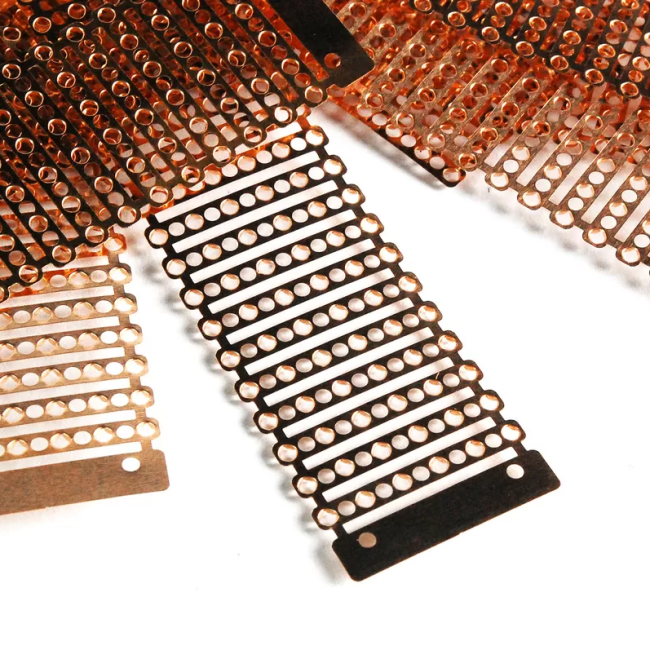
Content Menu
● 1. Excellent Electrical Conductivity
● 2. Superior Mechanical Strength
● 3. Corrosion Resistance
● 4. Thermal Conductivity
● 5. Cost-Effectiveness
● 6. Versatility in Applications
● 7. Environmental Considerations
● Conclusion
Surface Mount Technology (SMT) has revolutionized the electronics manufacturing industry, allowing for the production of smaller, more efficient devices. One critical component in SMT assembly is the splice clip, which is used to connect two pieces of wire or cable. The choice of material for these splice clips can significantly impact performance, reliability, and overall cost. Among the various materials available, copper stands out as a superior choice for SMT splice clips. This article explores the advantages of using copper in SMT splice clips compared to other materials such as aluminum, steel, and plastic.
1. Excellent Electrical Conductivity
One of the most significant advantages of copper is its exceptional electrical conductivity. Copper has a conductivity rating of approximately 59.6 x 10^6 S/m, making it one of the best conductors of electricity available. This property is crucial in SMT applications where efficient electrical connections are necessary for optimal device performance.
In contrast, materials like aluminum have lower conductivity (approximately 37.7 x 10^6 S/m), which can lead to increased resistance and potential heat generation at the connection points. This can result in energy loss and reduced efficiency in electronic devices. Steel, while strong, is not a good conductor and can introduce significant resistance in electrical connections. Plastic, on the other hand, is an insulator and cannot be used for electrical connections.
2. Superior Mechanical Strength
Copper splice clips offer superior mechanical strength compared to other materials. The tensile strength of copper is around 210 MPa, which allows it to withstand significant mechanical stress without deforming or breaking. This is particularly important in SMT applications where components may be subjected to vibrations, thermal cycling, and other mechanical forces during operation.
Aluminum, while lightweight, has a lower tensile strength (approximately 70 MPa) and can be more prone to deformation under stress. Steel, although strong, is heavier and can add unnecessary weight to the assembly. Plastic clips may be lightweight but lack the mechanical strength required for reliable connections in demanding environments.
3. Corrosion Resistance
Copper has inherent corrosion resistance, especially when compared to steel, which is prone to rust and degradation when exposed to moisture and other environmental factors. While aluminum also offers some level of corrosion resistance, it can suffer from galvanic corrosion when in contact with dissimilar metals.
In contrast, copper can be treated with various coatings to enhance its corrosion resistance further, making it suitable for use in a wide range of environments, including those with high humidity or exposure to chemicals. This durability ensures that copper splice clips maintain their integrity and performance over time, reducing the need for replacements and maintenance.
4. Thermal Conductivity
Another advantage of copper is its excellent thermal conductivity, which is essential in applications where heat dissipation is critical. Copper's thermal conductivity is about 401 W/m·K, allowing it to effectively transfer heat away from sensitive components. This property helps prevent overheating, which can lead to device failure or reduced performance.
In contrast, materials like plastic have poor thermal conductivity and can trap heat, potentially leading to thermal issues in electronic devices. While aluminum has decent thermal conductivity (approximately 237 W/m·K), it still falls short of copper's capabilities. The ability of copper splice clips to manage heat effectively makes them a preferred choice in high-performance applications.
5. Cost-Effectiveness
While copper may have a higher initial cost compared to some other materials, its long-term benefits often outweigh the upfront investment. The durability, reliability, and performance of copper splice clips can lead to lower overall costs in terms of maintenance, replacements, and energy efficiency.
Moreover, the reduced risk of failure associated with copper connections can minimize downtime and associated costs in manufacturing and operation. In contrast, cheaper materials like plastic may save money initially but can lead to higher costs in the long run due to their lower performance and reliability.
6. Versatility in Applications
Copper splice clips are versatile and can be used in various applications, from consumer electronics to industrial machinery. Their ability to perform well under different conditions makes them suitable for a wide range of SMT applications.
Other materials may be limited in their applications due to their specific properties. For example, plastic clips may be suitable for low-stress environments but are not ideal for high-temperature or high-stress applications. Steel clips may be strong but are often too heavy for compact electronic devices. Copper's versatility allows manufacturers to use it across various sectors, enhancing its appeal.
7. Environmental Considerations
Copper is a recyclable material, making it an environmentally friendly choice for SMT splice clips. The recycling process for copper is well-established, and recycled copper retains its properties, making it a sustainable option.
In contrast, materials like plastic can contribute to environmental pollution and are often not recyclable. Steel can be recycled, but the process is energy-intensive. By choosing copper, manufacturers can reduce their environmental footprint and contribute to a more sustainable future.
Conclusion
In conclusion, the advantages of using copper in SMT splice clips are numerous and compelling. Its excellent electrical and thermal conductivity, superior mechanical strength, corrosion resistance, and versatility make it the material of choice for many applications. While the initial cost may be higher than some alternatives, the long-term benefits in terms of reliability, performance, and sustainability make copper an economically sound choice. As the electronics industry continues to evolve, the demand for high-quality, reliable components will only increase, further solidifying copper's position as a leading material in SMT splice clips.




























